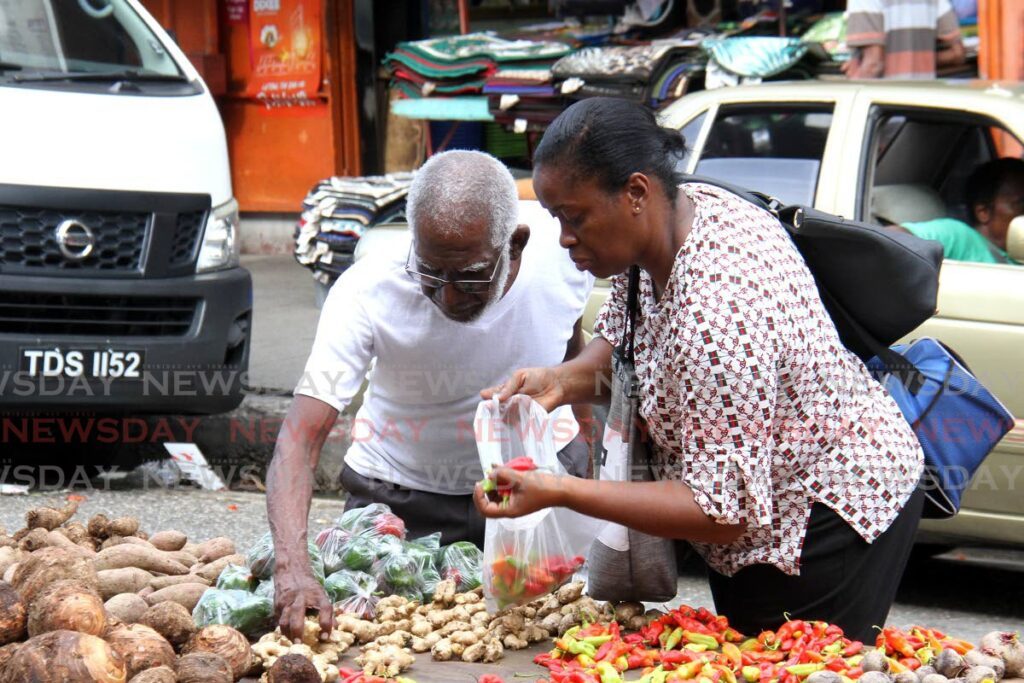Locally grown produce prices to remain high until Xmas

Consumers are not expected to see any reduction in the prices of locally grown produce for the Christmas as heatwaves experienced between October and November have affected the yield of farmers, according to president of the Agricultural Society of Trinidad and Tobago Darryl Rampersad.
Rampersad said the growing cycle of food crops had been affected by the heatwaves and production was not where it would normally be at this time of year.
“Production is based on the timing, seeing where we are now, usually the cycle is between three-four months and we’re seeing the Christmas season is six weeks away. The timeframe towards the end of the year, pertaining to timeliness in production, replanting, all of these things are not going to happen.
“For the past week or so, and not just because we have a religious holiday and celebration this week, you saw there was an increase in some of the prices, for example, cucumbers, hot peppers, tomatoes, melongene, and we need to brace our pockets because those high prices are going to remain as is from this point on throughout the Christmas season as well. The most we can expect is a little spike again instead of a decrease. Farmers won’t be able to make a profit/break even and supply the demand if the prices are lower.”

Rampersad said the main worry farmers had at this point was the possibility of flash flooding.
“As you’re aware, within Trinidad, if we get three days of rainfall consistently, it’s sufficient enough that we’ll have flash flooding in some of the farming projects. What is still worrying us from the point of production is that some of the planting projects still have not received proper attention in terms of agricultural infrastructure maintenance, for example, Orange Grove, Jerningham in Cunupia, even Felicity and Tabaquite.
“Why we were asking for the clearing of the drains in this area was for two purposes – when we had the heatwave, the channels could have been filled and used to irrigate crops, and now that we’re going back into the heavy rainfall, the same channels are going to be used to remove the additional water. But the issue is that some of them are so clogged that the water will not be able to leave in a timely manner in which we could salvage some of the crops out there.”
In its TT Dryness Monitor and Outlook by end of October report, issued on November 7, the Meteorological Service said there will be little to no concern for dryness by the end of January next year.
It said there will be borderline dryness at the end of January. It said this was based on the accumulated rainfall received nationwide during the months of August to October, together with the projected volume of rainfall for the months of November to January next year.

It said near normal rainfall is expected during the month of November, and being a wet season month, moderate to heavy rainfall events are expected to occur. Frequent rainfall events are expected to continue in December and January next year.
In its report, the Met Service said in August, Trinidad received below normal rainfall amounts whereas Tobago received above normal rainfall amounts. It said below normal rainfall amounts fell over both islands during the months of September to October.
In August, there were 13 relatively wet days, defined as having rainfall between one and ten mm, and four wet days, defined as having rainfall measuring over ten mm. Tobago had eight relatively wet days, three wet days and one excessively wet day, with over 50 mm of rainfall.
In September there was a drastic reduction of rainfall across both islands. Trinidad experienced eight relatively wet days and three wet days, while Tobago had six relatively wet days and three wet days.
October also had a significant reduction in rainfall across TT. Trinidad had three relatively wet days and five wet days, with Tobago having five relatively wet days and two wet days.
Piarco’s monthly total rainfall for August-September-October were 134.4 mm, 88.8 mm, and 116.5 mm respectively, while Crown Point, Tobago's monthly total rainfall for August-September-October were 224.9 mm, 96.5 mm and 44.9 mm respectively.
The Met Service said the three-month dryness indicator for August-September-October shows dryness indicator values that ranged from -2.4 to -1.2, which range between extremely dry to moderately dry.
The Met Service said its outlook is based solely on rainfall and should be used only as a guidance tool.

Comments
"Locally grown produce prices to remain high until Xmas"